#X-59 Quesst mission
Explore tagged Tumblr posts
Text
NASA to Participate in Space Symposium, Discuss Moon to Mars Strategy Implementation Through Artemis
NASA is one of the most renowned organizations in the world, and it is known for its contributions to the scientific world. The organization has been at the forefront of space exploration for decades and has made significant strides in discovering more about the universe. Recently, NASA announced that it would be participating in the Space Foundation’s 38th Annual Space Symposium, where NASA…

View On WordPress
#Artemis#human exploration#James Free#James Webb Space Telescope#Jim Reuter#Kenneth Bowersox#Moon to Mars#NASA#NASA TV#Nicola Fox#Pam Melroy#Robert Gibbs#space exploration#Space Symposium#space technology#subject matter experts#sustainable lunar presence#universe discovery#X-59 Quesst mission
1 note
·
View note
Text
NASA Targets 2024 for First Flight of X-59 Experimental Aircraft
https://enterprisewired.com/wp-content/uploads/2023/10/NASA-Targets-2024-for-First-Flight-of-X-59-Experimental-Aircraft.jpg
Share Post:
LinkedIn
Twitter
Facebook
Reddit
NASA’s Quesst mission has postponed the inaugural flight of its X-59 quiet supersonic aircraft to 2024. The X-59, an extraordinary experimental aircraft, has posed intricate engineering challenges for NASA researchers collaborating with the primary contractor, Lockheed Martin Skunk Works. Apart from its unique design, the X-59 incorporates innovative technology and components from various established aircraft, including its landing gear from an F-16 and its life-support system adapted from an F-15.
Additional time is required to integrate systems into the aircraft
Given the complexities involved in developing this exceptional aircraft, the Quesst team is diligently addressing several technical issues identified during the course of 2023, when the X-59 was initially slated for its maiden flight. Additional time is required to seamlessly integrate systems into the aircraft and ensure their proper functioning. The team is also resolving intermittent problems with some of the safety-redundant computers that oversee the aircraft’s systems.
Over the past year, Quesst has made consistent progress towards flight readiness. The team completed the finishing touches on the X-59’s tail structure, allowing them to finalize its electrical wiring and advance to critical ground tests. They also moved the aircraft from its assembly facility to the flight line for structural testing.
The X-59’s primary objective is to demonstrate the capability to achieve supersonic flight, exceeding the speed of sound, while minimizing the typical disruptive sonic boom to a subdued sonic thump. NASA intends to conduct flights over several communities to collect data on how people perceive the noise it generates. This data will be provided to U.S. and international regulators to potentially revise regulations that currently prohibit commercial supersonic flight over land.
Lockheed Martin X-59 finally unveiled in hangar rollout
youtube
Fully committed to a meticulous review and testing process
NASA places paramount importance on safety and mission success. For Quesst, this entails ensuring the X-59’s safety before it takes flight and ensuring its long-term reliability during the community test phase. The aircraft is currently undergoing comprehensive integrated testing, which must be successfully completed prior to its inaugural flight. Following this stage, the aircraft will proceed to a flight readiness review, during which NASA will unveil a more specific timeline for the first flight.
Quesst represents a mission with the potential to transform commercial aviation travel by significantly reducing travel times. Safely and reliably deploying the X-59 is crucial for NASA to realize the benefits of this mission. The agency is fully committed to a meticulous review and testing process to ensure the mission’s success.
Read More: New Asteroid Search Algorithm Detects Its First Dangerous Space Rock
20 notes
·
View notes
Video
youtube
NASA's X-59 Rollout Team Day - One Year Anniversary
Jan 13, 2025 As the X-59 prepares for its first flight, NASA and Lockheed Martin take a look back on the January 2024 unveiling of the centerpiece of the Quesst mission, the X-59 quiet supersonic research aircraft. See footage of how the team marked the milestone with the friends and family who have supported their efforts to build a one-of-a-kind X-plane.
0 notes
Text
X-59 Fires Up its Engine for First Time on Its Way to Takeoff
NASA’s Quesst mission marked a major milestone with the start of tests on the engine that will power the quiet supersonic X-59 experimental aircraft. These engine-run tests, which began Oct. 30, allow the X-59 team to verify the aircraft’s systems are working together while powered by its own engine. In previous tests, the X-59 used […] from NASA https://ift.tt/vsPI8FJ
0 notes
Link
NASA and Lockheed Martin publicly unveil the X-59 quiet supersonic research aircraft at a ceremony in Lockheed Martin’s Skunk Works facility in Palmdale, California. The X-59 is the centerpiece of NASA’s Quesst mission, which seeks to solve one of the major barriers to supersonic flight over land, currently banned in the United States, by making sonic booms quieter.
0 notes
Text
Sanfter Plopp statt lautem Knall: NASA will mit "Quesst" den Überschall-Flug revolutionieren
Ein Überschalljet ohne Überschall-Knall: Diese spektakuläre Neuerung will die NASA am Freitagabend vorstellen. Das futuristisch aussehende Fluggerät der NASA-Mission "Quesst" nennt sich "X-59", soll mit 1500 Kilometer pro Stunde fliegen und nur so laut sein wie das Schließen einer Autotür. Weiterlesen…

View On WordPress
0 notes
Text
Revolutionizing Air Travel: NASA's Ambitious Project to Cut New York to London Flight Time to 1.5 Hours
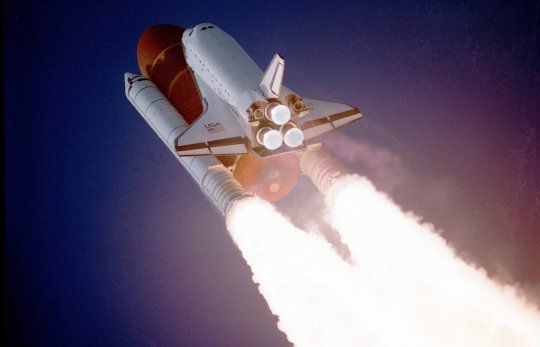
In a bid to redefine the future of air travel, NASA is delving into the realm of supersonic technology with a groundbreaking project that aims to drastically reduce the flight time between New York and London to a mere 1.5 hours. This ambitious endeavor falls under NASA's Commercial Supersonic Technology Project, signaling a new era of rapid and efficient global transportation. In contrast to the current passenger planes cruising at an average speed of 600 mph, NASA is setting its sights on revolutionizing commercial aviation with a supersonic jet capable of traversing the skies at speeds ranging from Mach 2 to Mach 4, equivalent to an astounding 1,535 to 3,045 mph. However, the journey to achieve this supersonic feat is not without its challenges. Present flight regulations across the United States and various nations prohibit supersonic jets from flying over land due to concerns over sonic booms causing noise pollution. Determined to overcome this hurdle, NASA has outlined two pivotal objectives to pave the way for supersonic flights over land. At the heart of these efforts is the Quesst mission, an initiative through which NASA is crafting the X-59 quiet supersonic aircraft. Distinguished by its innovative technology designed to mitigate the deafening roar of a sonic boom into a gentle, ground-level thump, the X-59 is poised to reshape the sonic landscape of supersonic flight. NASA's plan involves flying the X-59 over U.S. skies, meticulously analyzing the impact of its softened sonic boom on the populace. The objective is clear: to amass empirical data that will substantiate the case for revising the regulations barring overland supersonic flights. Drawing inspiration from the advancements achieved through the X-59 program, the commercial supersonic jet will emerge as the culmination of NASA's groundbreaking work. Lori Ozoroski, the esteemed project manager for NASA's Commercial Supersonic Technology Project, remarked, "A decade ago, we embarked on similar concept studies at Mach 1.6-1.8, and the insights gleaned from those studies have guided NASA's research trajectory ever since, including the pivotal strides toward the X-59." As the project accelerates, NASA is poised to award two 12-month contracts to select companies, tasking them with crafting comprehensive concept designs and technology roadmaps. These roadmaps will not only chart the uncharted territory of high-speed air travel but will also delineate potential risks, challenges, and essential technologies necessary to translate the vision of Mach 2-plus travel into an operational reality. Among the distinguished companies entrusted with these pivotal contracts are aerospace giants like Boeing and GE Aerospace, along with pioneering entities such as Rolls-Royce North American Technologies, Blue Ridge Research and Consulting, and Boom Supersonic. In essence, NASA's Commercial Supersonic Technology Project signifies a monumental leap forward in the realm of aviation. By harnessing cutting-edge innovations, rigorous research, and strategic partnerships, NASA is rewriting the narrative of air travel, offering a tantalizing glimpse into a future where crossing the Atlantic in less than two hours becomes not just a possibility, but a remarkable reality. Read the full article
0 notes
Text
Laying the Groundwork for a New Generation of Commercial Supersonic Aircraft
Cabin crew, prepare for takeoff. Engines roar; speed increases. You sip a cold beverage as the aircraft accelerates quietly past Mach 1 or around 600 mph. There’s no indication you’re flying over land faster than the speed of sound except when you glance at your watch upon arrival and see you’ve reached your destination in half the time. You leisurely walk off the plane with ample time to explore, finish a final report or visit a familiar face. This reality is closer than you think.

We’re on a mission to help you get to where you want to go in half the time. Using our single-pilot X-59 Quiet SuperSonic Technology (QueSST) research aircraft, we will provide rule-makers the data needed to lift current bans on faster-than-sound air travel over land and help enable a new generation of commercial supersonic aircraft.

The X-59 QueSST is unique in shape. Each element of the aircraft’s design will help reduce a loud sonic boom, typically produced by conventional supersonic aircraft, to a gentle sonic thump, making it quieter for people on the ground. To prove the quiet technology works, we will fly the X-59 over select U.S. communities to gauge the public’s response to the sound.
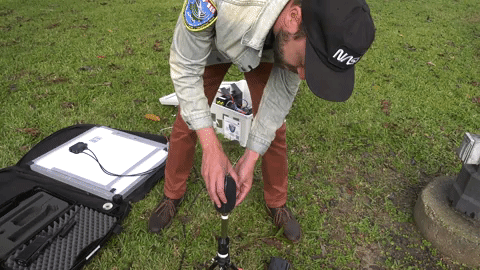
We are working with Lockheed Martin in Palmdale, California, to manufacture the X-59 and are making significant progress, despite the pandemic.
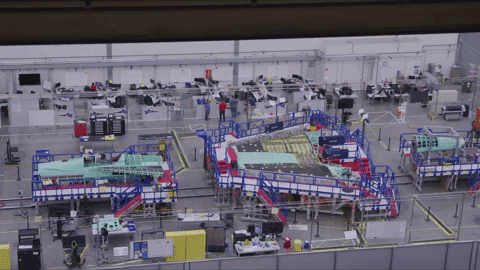
We finished the majority of work on the wing and closed its interior, marking the halfway point on construction of the aircraft.
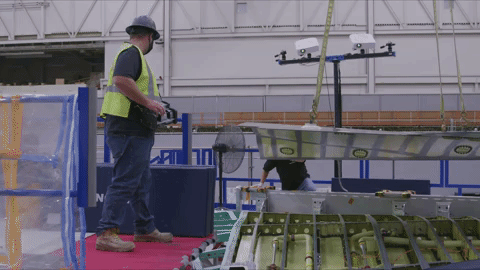
The X-59 team at Lockheed Martin completed the final touches by fastening skins to the wing. A special sealant is applied so that fuel can be carried in the wings of the aircraft.

Moving at a steady pace, technicians continue to work on many parts of the aircraft simultaneously. The forebody section of the aircraft will carry the pilot and all the avionics needed to fly the aircraft.
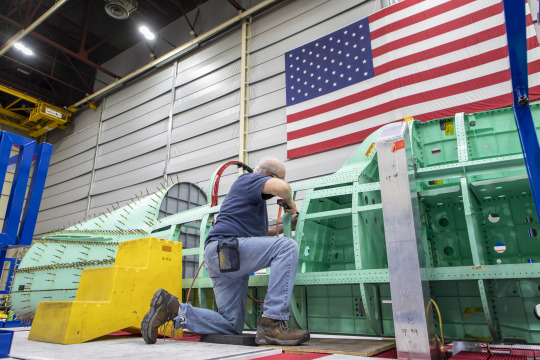
Because of the X-59’s long nose, the pilot will rely on an eXternal Vision System (XVS), rather than a window, for forward-facing visibility. The XVS will display fused images from an advanced computing system and cameras mounted on the upper and lower part of the aircraft’s nose.

The aft part of the aircraft will hold an F414 GE engine and other critical systems. Unlike typical aircraft, the engine inlet will be located on the upper surface of the X-59 and is one of many features that will help reduce the noise heard on the ground.
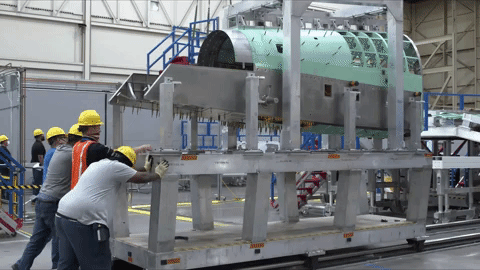
Over the next several months, the team will merge all three sections together. After final assembly in 2021, the X-59 will undergo numerous tests to ensure structural integrity of the aircraft and that ¬its components work properly. First flight of the aircraft will be in 2022 and community testing will start in 2024, making way for a new market of quiet commercial supersonic aircraft.

Want to learn more about the X-59 and our mission? Visit nasa.gov/X59.
Make sure to follow us on Tumblr for your regular dose of space: http://nasa.tumblr.com.
#NASA#aeronautics#X59#QueSST#supersonic#Quiet SuperSonic Technology#commercial aircraft#airplane#planes#flying#aero
1K notes
·
View notes
Text
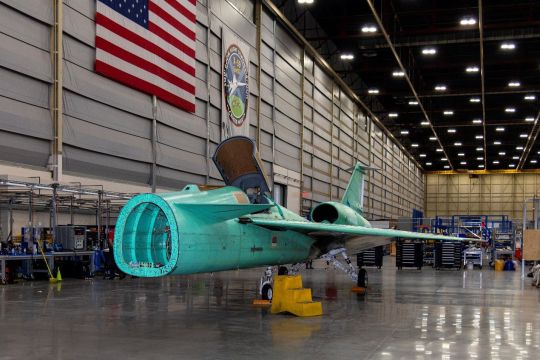
IMAGES: NASA's X-59 returns to California for final integration
Fernando Valduga By Fernando Valduga 04/19/22 - 2:30 PM in Technology
NASA's X-59 Quiet SuperSonic Technology (QueSST) research aircraft returned to Lockheed Martin's Skunk Works in Palmdale, California, after the completion of a series of ground tests in Fort Worth, Texas.
While at the Texas facility, structural and fuel calibration tests were completed on the aircraft in preparation for the final integration and taxi tests in Palmdale. The X-59 QueSST is part of NASA's low boom supersonic flight demonstration mission, which will test the technology designed to reduce "the volume of a sonic boom to a soft thud for people on the ground".
youtube
Ground tests on the X-59 were done to ensure the aircraft's ability to withstand the loads and tensions of supersonic flight - or flight at faster speeds than Mach 1. The vehicle's fuel systems were also calibrated and tested at the facilities in Fort Worth.

"Our unit in Texas already has facilities to perform the necessary types of tests," said Mike Buonanno of Lockheed Martin. “It would have been expensive and time-consuming to design and build them from scratch in Palmdale. But in Fort Worth they have the perfect facilities with a complete control room and all the support equipment needed to do these tests very efficiently."

NASA granted the $247 million contract to build the X-59 QueSST to Lockheed Martin in 2018 and announced in December 2020 that construction had reached half. The components yet to be installed include the aircraft engine and cockpit screens. The X-59 is provisionally scheduled for its first flight later this year with the aim of starting demonstration flights over communities in the U.S. from 2024.
Tags: NASAQueSST - Quiet Supersonic TechnologyTechnologyX-59
Fernando Valduga
Aviation photographer and pilot since 1992, he has participated in several events and air operations, such as Cruzex, AirVenture, Dayton Airshow and FIDAE. He has works published in a specialized aviation magazine in Brazil and abroad. He uses Canon equipment during his photographic work in the world of aviation.
Cavok Brasil - Digital Tchê Web Creation
3 notes
·
View notes
Text
X-59 QueSST more than the sum of its parts
Cleveland OH (SPX) Mar 13, 2020 A time-honored tradition employed by the aerospace community for decades is continuing with the assembly of NASA's X-59 Quiet SuperSonic Technology aircraft at the Lockheed Martin Skunk Works factory in California. Perfectly acceptable components from other aircraft - some major, some minor - are finding new life as parts installed on the X-59, an experimental airplane whose mission is to Full article
9 notes
·
View notes
Text
Unveiling the Future of Aviation: NASA's X-59 Redefines Supersonic Flight
NASA and Lockheed Martin publicly unveil the X-59 quiet supersonic research aircraft at a ceremony in Lockheed Martin’s Skunk Works facility in Palmdale, California. The X-59 is the centerpiece of NASA’s Quesst mission, which seeks to solve one of the major barriers to supersonic flight over land, currently banned in the United States, by making sonic booms quieter.NASA/Steve Freeman The…

View On WordPress
1 note
·
View note
Text
NASA's new X-59 supersonic plane gets engine for quiet sonic booms
NASA’s new X-59 supersonic plane gets engine for quiet sonic booms
NASA’s supersonic plane is now one step closer to its flight demonstration over U.S. communities. The X-59 supersonic plane of NASA’s Quesst mission just got its 13-foot-long engine, according to a recent announcement from the space agency. This crucial piece of hardware will deliver 22,000 pounds of thrust and fire up the X-59 to fly faster than the speed of sound. NASA hopes the data collected…

View On WordPress
0 notes
Text

NASA’s X-59, the centerpiece of the agency’s Quesst mission to help enable commercial supersonic travel over land, is seen in this illustration from Lockheed Martin, the company NASA contracted with to design, build, and conduct initial flight tests with the aircraft. First flight is targeted for 2023

0 notes
Text
NASA Sets Coverage for X-59 Quiet Supersonic Aircraft Rollout
NASA will provide live coverage as it reveals its X-59 aircraft at 4 p.m. EST on Friday, Jan. 12, as part of the agency’s Quesst mission to make commercial supersonic flight possible. For the first time, the public will see the painted aircraft, which will be unveiled during a ceremony hosted by prime contractor Lockheed […] from NASA https://ift.tt/puB1edy
0 notes
Text
NASA’s X-59 Quiet Supersonic Research Aircraft Cleared for Final Assembly
A milestone for NASA Aeronautics: our X-59 was cleared for final assembly and integration of its systems. The X-59 is an experimental piloted aircraft, designed to fly faster than sound without producing loud sonic booms. Data from the flights will help establish new rules to enable commercial supersonic air travel over land.

NASA’s first large scale, piloted X-plane in more than three decades is cleared for final assembly and integration of its systems following a major project review by senior managers held Thursday at NASA Headquarters in Washington.
The management review, known as Key Decision Point-D (KDP-D), was the last programmatic hurdle for the X-59 Quiet SuperSonic Technology (QueSST) aircraft to clear before officials meet again in late 2020 to approve the airplane’s first flight in 2021.
“With the completion of KDP-D we’ve shown the project is on schedule, it’s well planned and on track. We have everything in place to continue this historic research mission for the nation’s air-traveling public,” said Bob Pearce, NASA’s associate administrator for Aeronautics.

Image of the X-59 main assembly coming together. Credits: Lockheed Martin
The X-59 is shaped to reduce the loudness of a sonic boom reaching the ground to that of a gentle thump, if it is heard at all. It will be flown above select U.S. communities to generate data from sensors and people on the ground in order to gauge public perception. That data will help regulators establish new rules to enable commercial supersonic air travel over land.
Construction of the X-59, under a $247.5 million cost-plus-incentive-fee contract, is continuing at Lockheed Martin Aeronautics Company’s Skunk Works factory in Palmdale, California.
Three major work areas are actively set up for building the airplane’s main fuselage, wing and empennage. Final assembly and integration of the airplane’s systems – including an innovative cockpit eXternal Visibility System – is targeted for late 2020.
Management of the X-59 QueSST development and construction falls under the Low Boom Flight Demonstrator project, which is part of NASA’s Integrated Aviation Systems Program.
0 notes
